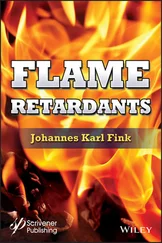1 ...6 7 8 10 11 12 ...36
1.4 Fire Safety and Non-Fire Safety Issues Requiring Non-Halogenated Flame Retardants
Depending upon the nature of a fire risk scenario and the codes/standards involved in regulating and testing materials with that particular scenario, there are cases where halogenated flame retardants cannot meet the fire safety requirements. These cases may result in non-halogenated FRs being favored for fire safety use. Typically, fire requirements around smoke and corrosive gas release limit the use of halogenated flame retardants. Smoke release may be limited in some compartment fires as the smoke may block visibility of exit signs or just visibility in general. Many halogenated flame retardants produce high levels of smoke upon burning since the halogenated flame retardants inhibit vapor phase combustion, thus leading to higher levels of smoke release [60–62]. Additionally, halogenated flame retardants often release corrosive gases during combustion (namely HBr and HCl), which can cause significant damage to electronics and electrical systems. Locations holding large numbers of computer servers, electronic data storage, and power switching systems typically have requirements against corrosive gases, and small compartments with sensitive electronics (aviation, maritime, aerospace) are likely to have similar requirements that limit or prevent the release of corrosive gases in a fire event. This can be compounded by heating, ventilation, and air conditioning (HVAC) systems that feed air into rooms holding these items, such that components in the ductwork or feeding air to the HVAC systems must also be non-halogenated to meet the corrosive gas requirement. Computer chip fabrication facilities also have corrosive gas emission requirements which often require the furniture, cabinetry, and items in the room to also be non-halogenated, or at least compliant by releasing little to not corrosive gases during a fire event [63]. Finally, there are some very strict combustion emission requirements for vehicles in extreme environments that have sealed atmospheres (submarines, spacecraft), and for that reason, corrosive gases are excluded with an emphasis on very low flammability first, and emissions second [64, 65].
Along with fire safety issues affecting the selection/de-selection of particular flame retardants, there are several non-fire safety issues that must be considered as well. Some of this was discussed in the previous section where specific chemicals are regulated, but it is worthwhile to review this again, as well as share some of the other requirements not specifically covered in chemical bans and chemical regulation. As mentioned previously, there are regulations which de-select halogenated flame retardants for environmental reasons, namely the WEEE and RoHS requirements covering electrical and electronic equipment. There are also voluntary labeling requirements which if met, allow additional branding of items to suggest that it has a better environmental profile than items that do not have this label. Examples of this include “ecolabels” like Blue Angel [66], European Union Ecolabel [67], Nordic Swan [68], Green Seal [69], Global GreenTag [70], and other relevant labels. These other labels may have a variety of non-fire related requirements which may de-select certain flame retardant chemicals. Recycling requirements and how a flame retardant chemical interacts with the recycling process (regrind & remelt, chemical depolymerization, waste-to-energy, etc.) may also prefer a particular flame retardant chemistry. Finally, there are issues with customer perception that will need to be addressed. For all the reasons mentioned above that are driving halogenated chemicals out of use where selected halogenated chemicals have negative PBT profiles, customers may demand non-halogenated even if the halogenated flame retardant can be made in such a way to have a positive PBT profile. The phrase “the customer is always right” is particularly true here if the customer is asking for non-halogenated flame retardant technology, even if it may be more expensive or the balance of properties in the final product is not as good as that possible with halogenated FRs. The same negative PBT data about halogenated FRs has led to consumer advocates/consumer influences asking for non-halogenated FRs in certain applications. To date, no one is clamoring for halogenated flame retardants, but there are many customer requests for non-halogenated FR use in consumer electronics and items that need fire protection, and have a short useful lifetime. The coming regulations seeming to ban all flame retardant chemicals by broad class may eventually lead to customer requests for no-flame retardant chemicals to be added to a product, and to instead use inherently low flammable materials. This latter request only holds if the cost is right, and for now, cost is still “king” in regards to what most consumers will pay. A consumer may specifically request non-halogenated chemistry and/or lower environmental impact items, but rarely will pay more for it.
Political considerations based upon perception of scientific information, rather than actual interpretation of data and studying the entire complex picture of fire safety and materials science, are indeed something that must be considered as a non-fire issue affecting flame retardant use. Perversely, these political motivations are moving to change the fire safety regulations to weaken them such that no flame retardant chemicals are needed. It is fair to state that sometimes regulations outlive their historical use as technology and consumer use trends change over time. But the materials do not change or lose their flammability with time. The main example of this political move is associated with polyurethane foam used in furniture. Polyurethane foam, due to its chemical structure, is a highly flammable material [71–75], and is just as flammable today as it was in the 1970s when fire safety regulations were first put in place around furniture. In the US, California Technical Bulletin #117 (TB-117) and Technical Bulletin #133 (TB-133) were put in place with small and large flame exposure tests to ensure the foams could not propagate a fire beyond that initial ignition source. As such, flame retardant chemicals were added to the polyurethane foam to allow them to pass this test and be sold into commerce. Some of those flame retardants were found to have negative PBT profiles, but instead of banning the critical flame retardants in question (which unfortunately takes a long time and is complicated), the fire safety standard was changed and morphed into a smolder-only test in 2013 [76]. This new test method may end up protecting against cigarette ignition sources causing furniture to ignite (although there is still a lot of debate about the effectiveness of this test) [77], but it provides no fire protection against open flame sources. While no flame retardants are required to pass the new TB-117 2013 test, the heat release of the polyurethane foam is still very high, and if it ignites, will still lead to major fire losses [24, 78]. To date, this is the only case of fire safety regulations becoming weakened to provide an incentive to not use flame retardant chemicals, but it is a dangerous precedent. Hopefully fire losses do not have to increase in California (and other places) before arguments are made to require higher levels of fire safety while also demanding no hazardous chemicals can be used.
1.5 Regulatory Outlook and Future Market Drivers
Based upon current information as of the writing of this chapter, the regulatory outlook appears to have more regulations of flame retardants, not less, in the coming decade. There will be regional pushes for regulations of chemicals, with the EU continuing to push the most regulation via existing protocols (RoHS, WEEE) and newer broader chemical registration programs (REACH). The US will remain fragmented at the state level since federal regulations will continue to be delayed until such time as the US legislative branch writes and passes new regulations. Some US states will continue to promote bans on flame retardant chemicals by class, rather than by specific structure. Other countries are expected to maintain their regulations, and perhaps selectively strengthen them where there is national will to do so. Because of the emphasis on PBT for chemical use, polymeric and reactive flame retardant use is expected to grow, while small-molecule additives/non-reactive flame retardant use is expected to shrink in the coming decade. Issues with plastic waste and end-of-lifetime/sustainability issues may further push some flame retardants out of use if they can migrate out of the plastic, or, prevent recycling or clean disposal of said plastic waste. Vigilance by fire safety scientists and fire safety engineers is required to push back against regulations which weaken fire safety under the guise of improving environmental and personal health and safety, as the pollution damage from accidental fires far outweighs the pollution from using flame retardant chemicals. That being said, we can have improved fire safety and eliminate chemicals of concern – it does not need to be one or the other. The correct choice of material and fire protection solution can deliver both, and fire safety regulations do not need to be weakened, nor do all chemicals with potential flame retardant benefit need to be regulated out of existence.
Читать дальше












